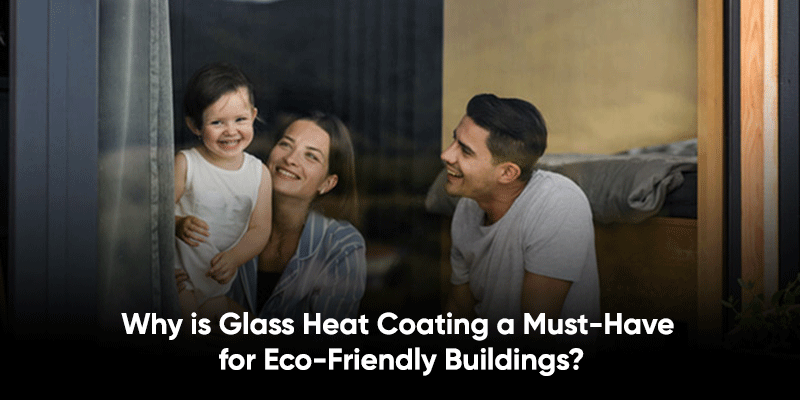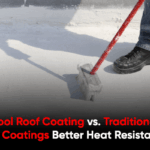
Why is Glass Heat Coating a Must-Have for Eco-Friendly Buildings?
The push for eco-friendly, energy-efficient buildings has made glass heat coating a game-changing solution. Unlike ordinary glass, these advanced coatings reduce heat gain in summer and heat loss in winter, helping cut energy bills and lower carbon emissions. Whether you’re upgrading a home, office, or commercial space, glass heat coatings improve comfort, boost sustainability, and support green building certifications like LEED. With rising energy costs and increasing environmental concerns, choosing Anti Heat Coating For Glass Surfaces is no longer just an option. It’s an essential step for any modern, eco-conscious building. Let’s explore why your project can’t afford to skip it.
What is Glass Heat Coating?
Glass heat coating is a thin, invisible layer applied to windows or glass façades to control heat transfer, making it a must-have for eco-friendly buildings and energy-efficient construction. By reflecting infrared and ultraviolet rays, these heat block coating for glass dramatically reduce energy loss through windows, one of the biggest culprits of heat inefficiency in both residential and commercial spaces. There are several types available:
- Low-E (Low Emissivity) Coatings: designed to block radiant heat while letting in natural light.
- Solar Control Coatings: specialised for reducing solar heat gain in hotter climates.
- Smart Glass Coatings: adaptive technologies that adjust tint or reflectivity based on sunlight or temperature, enhancing green building performance.
How Does Glass Heat Coating Cut Utility Bills?
Glass heat coatings offer impressive energy savings by reducing summer heat gain and winter heat loss, cutting your building’s reliance on heating and cooling systems. This means less work for your HVAC, translating to lower utility bills and reduced energy waste year-round.
Beyond financial savings, these coatings significantly boost indoor thermal comfort, keeping interiors cooler in summer and warmer in winter. For homeowners and businesses aiming for sustainable building design or LEED certification, installing heat-control glass coatings is a smart, cost-effective way to achieve long-term energy efficiency and environmental impact reduction.
How Glass Heat Coating Lowers Carbon Emissions?
Installing glass heat coatings is one of the most effective ways to reduce a building’s carbon footprint without expensive structural overhauls. By minimising heat transfer, these coatings decrease the energy demand for heating and cooling systems, which in turn cuts greenhouse gas emissions.
For builders and property owners aiming for green building certifications like LEED or BREEAM, glass heat coatings play a vital role. They not only boost a project’s energy performance score but also align with global sustainability standards making them a commercially smart, eco-friendly upgrade for residential, commercial, and industrial spaces.
Glass Heat Coating vs Solar Panels: Why You Need Both?
While solar panels generate renewable energy, they don’t prevent energy loss from inefficient windows. That’s where heat-reducing glass coatings come in, working alongside solar panels to maximise overall building efficiency. By keeping interiors cool, these coatings reduce the load on HVAC systems, meaning the energy your solar panels produce goes further.
This powerful combination of passive solutions (glass coatings) and active systems (solar panels) creates a high-performing, low-energy building design, delivering maximum savings, reduced emissions, and stronger long-term ROI for eco-conscious homeowners and businesses.
Where Do Glass Heat Coatings Work Best?
Glass heat coatings are versatile and valuable across a range of building types.
For homeowners, these energy-efficient window coatings help lower electricity bills by reducing heat transfer and improving indoor comfort, an excellent upgrade for eco-friendly homes.
In commercial office buildings, glass coatings significantly cut operational costs by lowering HVAC energy use, improving thermal regulation, and supporting sustainability goals.
For industrial facilities, where maintaining specific indoor temperatures is critical (such as in manufacturing or storage), heat-resistant glass coatings help protect sensitive environments while contributing to overall green building performance and long-term energy savings.
Is Glass Heat Coating Worth the Investment?
The average cost of installing glass heat coatings in eco-friendly buildings ranges from ₹250 to ₹500 per square foot, depending on coating type, project size, and building design. While upfront costs may seem high, the long-term ROI is impressive, thanks to continuous savings on energy bills, reduced HVAC maintenance, and extended window lifespan.
By investing in heat-control window films or coatings, property owners can achieve payback within a few years, all while increasing building value, boosting sustainability credentials, and ensuring better environmental performance.
Smart Glass Coatings and Emerging Technologies
The future of glass heat control lies in smart, adaptive coatings that adjust their tint or reflectivity automatically based on sunlight, temperature, or occupancy, creating real-time energy savings and improving occupant comfort.
Advances in nanotechnology are also driving the development of ultra-thin, high-efficiency glass coatings that offer transparent thermal insulation glass coating without compromising on light transmission. These innovations are reshaping the way architects and builders approach sustainable building design, ensuring present projects remain energy-efficient, cost-effective, and eco-friendly well into the future.
HeatCure Glass Heat Coating in India
HeatCure Glass Heat Coating is transforming how Indian homes, offices, and commercial spaces tackle rising temperatures and energy costs. Its advanced nanotechnology-based formula is specially designed for India’s climate, offering a simple yet powerful solution to boost energy efficiency and sustainability.
- Reduces indoor temperatures by up to 15°C even during peak summer.
- Cuts air conditioning energy bills by up to 30%.
- Works seamlessly on existing glass (no need for replacements).
- Blocks harmful UV rays, protecting interiors and furniture.
- Maintains natural light without darkening the glass.
- Offers long-lasting durability with minimal maintenance.
- Ideal for residential, commercial, and industrial applications.
Whether you’re a homeowner, architect, or facility manager, HeatCure provides a cost-effective, eco-friendly upgrade that delivers real results. Contact the HeatCure team today for a free site assessment or to request a customised quote and start transforming your space into a cooler, greener, and more energy-efficient environment.
Final Thoughts
Ready to make your building more energy-efficient and eco-friendly? Start by consulting a certified glass heat coating installer or green building contractor who can assess your property’s specific needs. They’ll recommend the right type of Low-E, solar control, or smart glass coating based on your climate, building use, and energy goals.
Request quotes, compare products, and check warranties to ensure long-term performance. Investing in heat-reducing glass coatings not only cuts energy costs but also boosts your building’s sustainability, increases comfort, and enhances its resale value, making it a smart upgrade for any forward-thinking homeowner or business.


Comment (0)